FORM ONE
INTRODUCTION TO GEOGRAPHY
The meaning of Geography

Scientific study of the earth as a home of man.
Study of interrelationship on natural and human phenomena on the earth’s surface.
Environment
The surroundings
All external conditions surrounding an organism which has influence over its behaviour.

Environment can be divided into two:
1. The Physical Environment
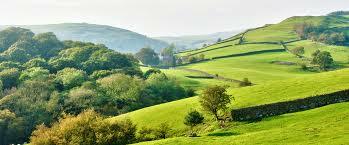
Natural physical conditions of weather, climate, vegetation, animals, soil, landforms and drainage.
2. The Human Environment

Human activities such as farming, forestry, mining, tourism, settlement, transportation, trade and industry.
Branches of Geography
1. Physical Geography
Deals with the study of natural physical environment of human kind.
The areas covered include:
a) Geology-study of the origin, structure and composition of the earth. It includes study of rocks.
b) Geomorphology- the study of internal and external land forming processes and landforms.
c) Climatology- the study of climate and weather
d) Pedology- the study of soils
e) Biogeography - the study of soils, vegetation and animals.
f) Hydrology- the study of water bodies
g) Spatial geography-study of space
2. Human and Economic Geography
-Study of people and their activities on the earth’s surface.
The areas covered include:
a) Mining
b) Forestry
c) Agriculture
d) Fishing
e) Wildlife and tourism
f) Industry
g) Energy etc.
3. Practical Geography
-A smaller branch which equips the learner with practical skills that enhance their understanding and interpretation of human and physical geographical information.
The areas are:
a) Statistical methods
b) Map work
c) Field work
d) Photograph work
Importance of Studying Geography
1. Facilitates good relationship among nations by studying geography of other regions of the world.
2. it’s a career subject in that it enables one to go for advanced studies in specialised fields e.g. geography teachers, meteorology, surveying etc.
3. Enables us to appreciate other people’s way of life by learning economic activities of different communities within our country and other parts of the world.
4. Enables us to conserve our environment when we learn negative and positive effects of human activities on the environment.
5. Enables us to conserve our resources when we learn wise use of resources in conservation and management of resources e.g. wildlife, forests, energy, etc.
6. Inculcates in us virtues of cooperation and patience as we work in groups.
7. Makes us to appreciate manual work as we are involved in practical geography which may lead to self employment.
8. Promotion of industry such as tourism by guiding tourists to places of interest by using maps, calculations of distances etc.
Relationship between Geography and Other Subjects
1. Mathematics-mathematical techniques are used in drawing graphs and pie charts and mathematical formulae are used in geography to calculate distances, areas, population density, population densities, etc.
2. History-history uses geographical tools like maps, charts and graphs to show where past events took place e.g. the movement of people in the past.
3. Biology-Geography explains the distribution of organisms and factors influencing their distribution on the earth’s surface.
4. Physics-geography uses physics principles and formulae to calculate and describe aspects such as magnetic field, gravity, vibrations of the earth etc.
5. Chemistry-geography applies chemistry in studying chemical composition and chemical changes which take place in soils and rocks.
6. Agriculture-geography studies farming systems, their distribution and factors affecting farming activities.
7. Meteorology-geography uses meteorological information in the study of weather and in classifying climatic regions and mapping them.
8. Geology-geography studies rocks.
The Earth and the Solar System
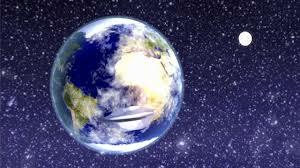
Solar system is the group of heavenly bodies comprising the sun and the nine planets.
The origin of the Solar System
Theories
A theory is a set of reasoned ideas intended to explain facts or events
1. Passing Star Theory
A star with a greater gravitational pull passed near the sun
It attracted large quantities of gaseous materials from the sun
The materials split, cooled and condensed to form planets
The planets were set in orbit by the passing star
Weaknesses
Doesn’t explain the origin of the sun and star.
Minimal chance of a star approaching another
Materials would disperse than condense
2. Collision Theory
Star with greater gravitational pull passed near the sun
It attracted large quantities of gaseous materials
The materials split into portions
Large portions collided with smaller ones and swept them to form planets.
The weaknesses are the same as the passing star’s Theory.
3. Nebula Clod Theory
There was a slowly rotating cloud of dust and gas called Nebula
It cooled and began to contact
Rotation speed increased and successive rings of gaseous materials were formed.
The rings condensed to form planets
The central gaseous material remained as the sun
Evidence
Rotation and revolution of planets in anticlockwise direction
Weakness
The origin of nebular is not explained.
4. Supernova/explosion Theory
There was a violent explosion of a star.
A cloud of dust (nebular) remained from the star.
There was fast movement of the cloud due to the force of explosion.
Rotation speed increased due to gravitational attraction
The cloud flattened into a disc.
The matter began to accumulate towards the centre to form a proto-sun which later began to shine.
The rest of the cloud collapsed to form planets.
Weaknesses
Doesn’t explain the origin of the star
Doesn’t explain the cause of explosion
Composition of the Solar System
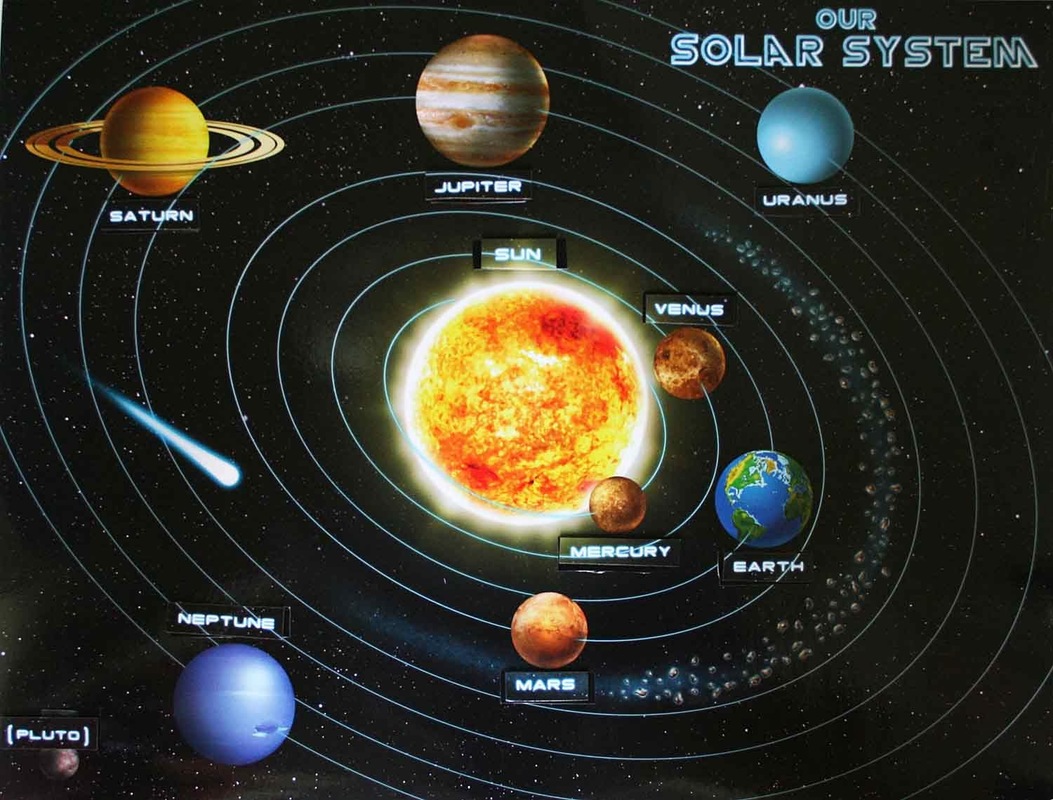
1. The Sun
It’s the centre of the universe.
Characteristics
It’s a star.
A star is a heavenly possessing its own light which it transmits.
Nebula/galaxy is a cluster of stars.
The earth is in a galaxy called The Milky Way.
It’s made of very hot gases mainly hydrogen (70%) and helium (30%).
Has a diameter of 1392000km.
Surrounded by a layer of gas which has boiled from its surface which is called corona.
Rotates on its own axis in anticlockwise direction.
Has gravitational pull which holds all the planets in orbit around it.
An orbit is a path which a planet or a satellite follows around a star or a planet.
Temperature at its centre is 15m◦c and at the surface is 5500◦c.
Radiates solar energy which is very important for all forms of life on the earth.
2. The Planets.
Planets are large spherical celestial/heavenly bodies in space.
There are 9 planets in our solar system.
Characteristics
Spherical in shape
Don’t have their own light but reflect it from the sun.
Revolve around the sun in anticlockwise direction.
Have their own force of gravity
Only one is known to support life.
The following are the planets arranged in order from the one nearest to the sun.
Mercury
Nearest from the sun
Its 58m km from the sun
Has no satellites
Takes approximately 88 earth days to revolve around the sun
Venus
2nd planet from the sun
It’s 108m km from the sun
One of the brightest planets
Can be seen clearly with naked eyes
Takes approximately 225 earth days to revolve around the sun
Slightly smaller than the earth
Has no satellites
Together with the earth they are called twin planets due to having many similarities
Earth
The 3rd planet from the sun
The earth and the heavenly bodies make the universe
The only planet that supports life
The home of man
Approximately 149m km from the sun
Takes 365 ¼ days to revolve around the sun
Has one satellite, the moon
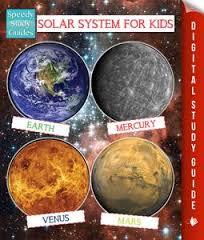
Mars
Also called The Red Planet because when it’s observed through a telescope it appears reddish.
The 4th from the sun
Slightly smaller than the earth
Approximately 228m km from the sun
Takes 687 earth days to revolve around the sun
Between Mass and Jupiter there are small celestial bodies called planetoids.
Has no satellite.
Jupiter
5th planet from the sun
Approximately 778m km from the sun
Largest in the universe
Rotates on its own axis at very fast speed
Has flattened poles due to its fast speed of rotation
Has very thick layers of ice on its surface
takes 12 earth years to revolve around the sun
Has 16 satellites
Saturn
6th planet from the sun
Second largest planet
Approximately 1427m km from the sun
Takes 29 ½ earth years to revolve around the sun
Has a ring around it
Has 18 satellites
Uranus
7th planet from the sun
About 4 times bigger than the earth
Approximately 2870m km from the sun
Also rotates very fast
Also has flattened poles due to fast speed of rotation
It appears greenish foe being surrounded by methane gas
Has 8 satellites
Takes 84 earth years to revolve around the sun
Neptune
One of the farthest from the sun
8th planet from the sun
Approximately 4497m km from the sun
Has 8 satellites
Takes 165 earth years to revolve around the sun
Very similar in size, colour and character with Uranus
Pluto
9th planet from the earth
Farthest from the sun
The smallest
1/6 the size of the earth
Approximately 5900m km from the sun
Takes 248 earth years to revolve around the sun
Has one satellite
Very little is known about it
Other Celestial Bodies
Natural Satellites
Any natural heavenly body that orbits around a planet e.g. moon for earth, tritan for Saturn and Triton for Neptune.
Asteroids/Planetoids
Also called minor planets.
Are small fragments of rocks left going around the sun when the solar system was formed
Found between Mass and Jupiter
Are 1500 in number
They sometimes collide with each other and planets due to Jupiter’s gravitational pull causing them to move in erratic orbits.
Comets
Heavenly bodies which appear to have a head and a long tail
Made of ice, dust and frozen gas
The head is made of many particles of dust, rock and frozen gases.
Their tail is made of gases and points away from the sun.
Move around the sun in extremely long and oval orbits
Their orbits cross the earth’s orbits e.g. Halley’s Comet which appears after every 76 years.
Meteoroid
Small heavenly body which strays from its orbit in the solar system and enters the earth’s atmosphere at very high speed.
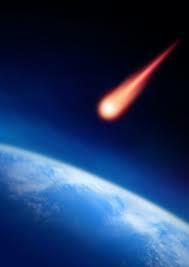
Meteor
A meteoroid which is burning out due to friction after entering the earth’s atmosphere.
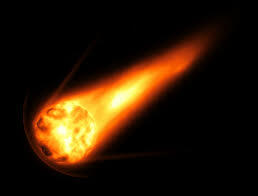
Meteorite
Remains of a meteoroid which have reached the earth’s surface or incompletely burnt up meteoroid.
When they fall they sink into the ground forming craters
They are rich in iron
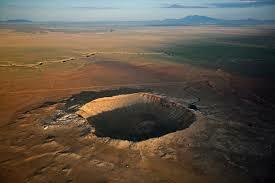

The Moon
A natural satellite
Receives its light from the sun and reflects it onto the earth.
It revolves around the earth
Takes 29.5 days to complete one revolution around the earth
Its orbit is almost circular
As it revolves around the sun it appears in various shapes ranging from crescent/new moon, half moon, gibbons moon and full moon.
Has gravitational pull which causes the rising and falling of the ocean level
As the moon orbits around the earth it creates an event called eclipse.
Eclipse
-Phenomenon occurring when the rays of the sun are blocked from reaching the earth or the moon.
Solar/Sun Eclipse

The moon comes between the earth and the sun
The moon’s shadow is cast on the earth
The sun appears to be covered by darkness
Lunar/moon Eclipse

The earth comes between the moon and the sun
The earths shadow is cast on the moon
The moon appears to be covered by darkness
The Origin of the earth
A star with a greater gravitational pull passed near the sun
It attracted large quantities of gaseous materials from the sun
The materials split, cooled and condensed
Heavier materials collected at the centre to form the core
Less dense materials collected around the core to form the mantle
The lightest materials formed the crust
The shape of the earth
The shape of the earth is called geoid/ovoid/oblate spheroid due to being an imperfect sphere by being wide at the equator and flat at the poles.
Proofs/Evidence That the Earth Is Spherical
1. If one moves towards the east in a straight line he will end up where he started.
2. Satellite photographs taken from space show that the earth is like a sphere.
3. Places in the east see the sun earlier than those in the west.
4. When a ship is approaching the smoke is seen first, then the mast and finally the whole ship.
5. All the planets are spherical so the earth being one of them is also spherical.
6. During the moon eclipse the earth casts a spherical shadow on the moon.
7. The earth’s horizon appears curved when observed from a very high point like a tower.
The size of the earth
Equatorial diameter-12756km
Equatorial circumference-40085km
Polar diameter-39995km
Surface area of the earth-510×106 km2
Water surface-73%.
The Movement of the Earth
There are 2 movements of the earth namely:
1. Rotation of the earth on its axis
2. Revolution of the earth around the sun
Rotation of the Earth
-Movement of the earth on its own axis (imaginary line through the centre from N pole to S pole.
Rotates through 360◦.
Takes 24 hours (day) to complete 1 rotation.
Rotates in an anticlockwise direction (west to east).
Effects of Rotation of the Earth
1. Creates day and night because at any one time one side of the earth faces the sun (day) and the other remains in darkness (night).
2. Causes deflection of winds and ocean currents in the N hemisphere to the left and in the S hemisphere to the right.
3. It causes rising and falling of ocean tides.
4. Causes time difference between longitudes.
Takes one hour to go through 15◦. 4 min to go through 1◦.
Calculation of Local Time
-The time recorded in places within the same longitude.
A longitude is an imaginary line running from N to S which shows how far E or W a place is from the prime meridian.
Greenwich Meridian (0◦) longitude is the point of reference when calculating time.
Time is gained towards the E and lost towards the W.
Examples
1. Suppose the time at GWM is 12 noon what is the local time at Watamu 40◦E?
Time gained=40×4=160min=2 hours 40min
Local time at Watamu is 12.00+2.40=14.40-1200=2.40pm.
2. At Dar-es-Salaam 40◦E time is 12pm what is the time at Ecuador 40◦E?
40◦+20◦=60◦
60×4=240min=4hours
Ecuador is behind in time =12.00-4=8 am.
If the places are on the same side subtract the degrees to get the difference and add or subtract from the reference time depending on which side the place is.
Calculation of Longitude
What is the longitude of place x whose local time is 8 am when local time at GWM is noon?
Time difference =12.00-8=4 hours
Degrees=4×15=60◦
Since x is behind in time its then 60◦W.
Standard Time and Zones
Standard time is time recorded by countries within the same time zone.
Standard time was come up with due to confusion resulting from time changing at every longitude.
The world has 24 time zones.
The International Date Line
It’s the 180◦ longitude.
Effects of Crossing It
One gains time when he crosses it from W to E and has to adjust the clock ahead by 24 hours.
One loses time when he crosses it from E to W and has to adjust the clock backwards by 24 hours.
Revolution of the Earth
Movement of the earth in its orbit around the sun.
It’s in anticlockwise direction.
The orbit of the earth’s revolution is elliptical.
Takes 365 ¼ days in a year or 366 days in a leap year (every 4 years).
The sun moves from the tropic of cancer to the equator and then towards tropic of Capricorn and back to the tropic of cancer.
21st march and 23rd September are called equinoxes because the length of day and night is equal. The sun is vertically overhead at noon at the equator.
21st June is called summer solstice because its summer in the N hemisphere. The sun is vertically overhead at noon at the tropic of cancer.
22nd December is called winter solstice because its winter in the S. hemisphere. The sun is vertically overhead at noon at noon at the tropic of Capricorn.
Solstice is the period of maximum tilting of the earth towards the sun.
Effects of the Revolution of the earth
1. Causes the four seasons summer, autumn, winter and spring due to the movement of overhead sun causing changes in the heat belt.
2. Causes variation of day and night’s lengths due to the earth’s axis being inclined to the path of revolution at an angle of 60◦.
Equinoxes have equal lengths of day and night.
Summers have longer days and shorter nights.
Winters have longer nights and shorter days.
3. Causes changes in the altitude of the midday sun due to the earth’s orbit being elliptical.
Highest altitude during equinox
Lowest altitude during solstices
4. Causes lunar eclipse due to revolution bringing the earth in line with the sun and the moon.
The Structure of the Earth
Internal Structure of the Earth
The evidence used to study the earth’s interior are
1. mining
2. drilling
3. quarrying/excavation
A. Crust/Lithosphere
Outermost layer of the earth
Made of soils and other loose deposits of sand
The dominant rocks are granites.
Extends 0-50km
Has 2 layers
1. Sial
Also called continental crust
Made of light coloured rocks
Called sial because it’s made up of silica and aluminium.
2. Sima
Also called oceanic crust
Mainly made of basaltic rocks which are brittle.
Called sima because it is made of silica magnesium and iron.
Mohorovicic Discontinuity (Moho)
A definite zone of discontinuity between the crust and the mantle.
Was discovered by Dr. Andrija Mohorovicic in 1909.
B. The Mantle/Asthenosphere
Layer lying between the crust and the core
Made of iron and magnesium
Has two layers
1. Upper mantle
Rocks are more elastic than those of sima.
Temperature is about 1000◦c.
2. lower mantle
Rocks are like very viscous liquid.
Temperature ranges between 1000◦c to 3000◦c.
Why the Interior of Earth Is Very Hot
a) Due radio-active decay causing most of the heating.
b) Due to great pressure as a result of overlying crustal materials.
c) The original heat resulting from slow cooling of the materials which were pulled off the sun
Gutenberg Discontinuity
A definite zone of discontinuity between mantle and core.
C. Core/barysphere/Centrosphere
The innermost/central layer of the earth.
Has 2 layers
Outer Core
Composed of very dense rocks
Made up of nickel and iron
Temperatures are up to 3700◦c.
Inner Core
A solid mass of mainly iron
Temperatures are estimated to be 4500◦c to 5000◦c.
External Structure of the Earth
a) The Atmosphere
Layer of gases surrounding the earth.
The earth revolves with it because its held onto it by gravity
It’s about 330km thick.
Composition of the Atmosphere
a) Gases-exist as a mixture
b) Smoke particles
c) Dust particles
d) Water vapour
The structure of the Atmosphere
It’s divided into 4 layers/zones namely:
1. Troposphere
Lowest layer of the atmosphere
Contains 90% of water vapour
Rainfall is got from it
Temperature decreases with increase in altitude (lapse rate)
Air is turbulent due to mixing of air
Contains dust particles
There is a zone of transition between troposphere and stratosphere called tropopause.
2. Stratosphere/ozonosphere
Layer lying next to troposphere
Has layers
Lower isothermal layer in which temperature is constant
Upper layer of temperature inversion in which temperature increases with increasing altitude
Has ozone layer which absorbs harmful ultraviolet radiation.
Air is calm so its used by passenger jets
Limited amounts of water vapour
There is a zone of transition between stratosphere and mesosphere called stratopause.
3. Mesosphere
Middle layer of the atmosphere.
Temperature decreases with increasing altitude.
There is a zone of transition between mesosphere and thermosphere called mesopause which is an inversion layer.
4. Thermosphere/ionosphere
High radiation is present.
The pressure is very low.
Gases and molecules in this layer exist as ions due to high radiation.
Has no definite top but merges gradually into the outermost part of the atmosphere called exosphere.
Exosphere consists of rare gases like hydrogen and helium.
Beyond the atmosphere there is the outer space.
Outer space is the universe beyond the atmosphere in which other planets and stars exist.
Significance of Atmosphere
a) Animals and plants breathe in from it oxygen for respiration.
b) Plants use carbon dioxide from it for photosynthesis.
c) Water vapour in the atmosphere condenses to form clouds which give us rain.
d) Ozone layer in the stratosphere shields us from ultraviolet radiation which may cause cancers.
e) Carbon dioxide and methane in the atmosphere cause global warming through the green house effect.
b) The Hydrosphere
Part of the earth’s surface covered by water masses e.g. oceans, seas, lakes, rivers and even underground water.
It comprises 73% of the earth’s surface area.
The atmosphere and hydrosphere are related in that atmospheric gases penetrate to the ocean depth in solution form.
The lower atmosphere, hydrosphere and the upper part of the earths crust are called biosphere meaning the sphere of the earth in which organic life exists.